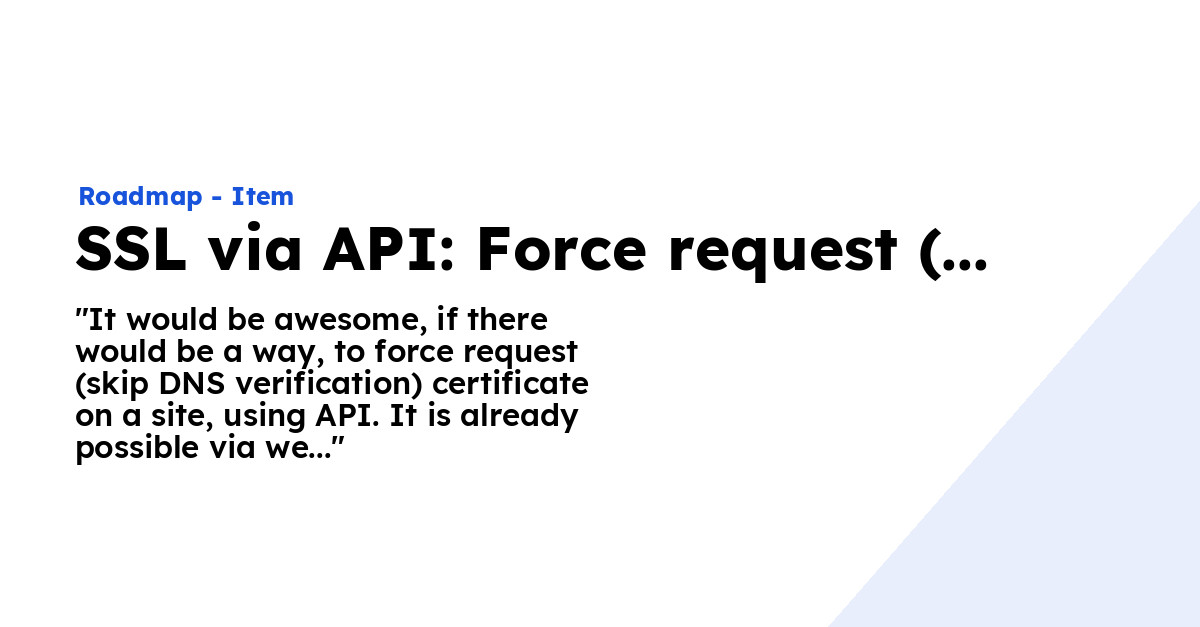Welcome to Roadmap, the open-source software for your roadmapping needs 🛣
- Completely customisable roadmapping software
- Mention users in comments
- Upvote items to see which has more priority
- Automatic slug generation
- Filament admin panel 💛
- OAuth 2 single sign-on with your own application
- Automatic OG image generation including branding color you've setup (saves in your storage, around 70kb per image), if title is too long it will strip automatically as well, example:
- PHP >= 8.1
- Database (MySQL, PostgreSQL)
- GD Library (>=2.0) or
- Imagick PHP extension (>=6.5.7)
First set up a database, and remember the credentials.
git clone https://github.com/ploi-deploy/roadmap.git
composer install
php -r "file_exists('.env') || copy('.env.example', '.env');"
php artisan key:generate
php artisan storage:link
npm install
npm run production
Now edit your .env file and set up the database credentials, including the app name you want.
Optionally you may set up the language with APP_LOCALE, if your language is not working we accept PR's for new languages. We recommend copying those files from the lang/en folder.
As well as the timezone can be set with APP_TIMEZONE, for example: APP_TIMEZONE="Europe/Amsterdam".
Now run the following:
php artisan migrate --force
php artisan make:filament-user
And login with the credentials you've provided. If you want to be admin user, change the admin column for your user from 0 to 1.
To manage your servers and sites, we recommend using Ploi.io to speed up things, obviously you're free to choose however you'd like to deploy this piece of software 💙
That being said, here's an deployment script example:
cd /home/ploi/example.com
git pull origin main
composer install --no-interaction --prefer-dist --optimize-autoloader --no-dev
echo "" | sudo -S service php8.1-fpm reload
php artisan route:cache
php artisan view:clear
php artisan migrate --force
npm install
npm run production
echo "🚀 Application deployed!"If you're using queue workers (which we recommend to do) also add php artisan queue:restart to your deployment script.
It is possible to configure OAuth 2 login with this roadmap software to make it easier to log in. In this example we're going to show how to set this up with a Laravel application example, but any other OAuth 2 capable application should be able to integrate as well.
Start by installing Laravel Passport into your application, consult their docs how to do this.
Now create a fresh client by running php artisan passport:client
It will ask you a few questions, an example how to answer these:
$ php artisan passport:client
Which user ID should the client be assigned to?:
>
What should we name the client?:
> Roadmap SSO
Where should we redirect the request after authorization? [https://my-app.com/oauth/callback]:
>
New client created successfully.
Client ID: 3
Client secret: 9Mqb2ssCDwk0BBiRwyRZPVupzkdphgfuBgEsgpjQ
Enter these credentials inside your .env file of the roadmap:
SSO_LOGIN_TITLE="Login with SSO"
SSO_BASE_URL=https://external-app.com
SSO_CLIENT_ID=3
SSO_CLIENT_SECRET=9Mqb2ssCDwk0BBiRwyRZPVupzkdphgfuBgEsgpjQ
SSO_CALLBACK=${APP_URL}/oauth/callback
Next we're going to prepare the routes, controller & resource for your application.
Create these routes inside the api.php file:
Route::get('oauth/user', 'UserOAuthController@user')->middleware('scopes:email');
Route::delete('oauth/revoke', 'UserOAuthController@revoke');Create the resource: php artisan make:resource Api\UserOAuthResource with the following contents in the toArray() method:
public function toArray($request)
{
return [
'id' => $this->id,
'name' => $this->name,
'email' => $this->email,
];
}Create a controller php artisan make:controller Api\UserOAuthController and add these functions:
use App\Http\Resources\Api\UserOAuthResource;
use Laravel\Passport\RefreshTokenRepository;
use Laravel\Passport\TokenRepository;
public function user(Request $request)
{
return new UserOAuthResource($request->user());
}
public function revoke(Request $request)
{
$token = $request->user()->token();
$tokenRepository = app(TokenRepository::class);
$refreshTokenRepository = app(RefreshTokenRepository::class);
$tokenRepository->revokeAccessToken($token->id);
$refreshTokenRepository->revokeRefreshTokensByAccessTokenId($token->id);
}Also setup the tokens inside the AppServiceProvider inside the boot() method:
public function boot()
{
...
Passport::tokensCan([
'email' => 'Read email'
]);
}Now head over to the login page in your roadmap software and view the log in button in action. The title of the button can be set with the .env variable: SSO_LOGIN_TITLE=
composer testPlease see CHANGELOG for more information on what has changed recently.
Please see CONTRIBUTING for details.
We appreciate sponsors, we still maintain this repository, server, emails and domain. You can do that here. Each sponsor gets listed on in this readme.
Obviously, if you do not want to self host, there's plenty of self-hosted solutions, a small rundown:
The MIT License (MIT). Please see License File for more information.

